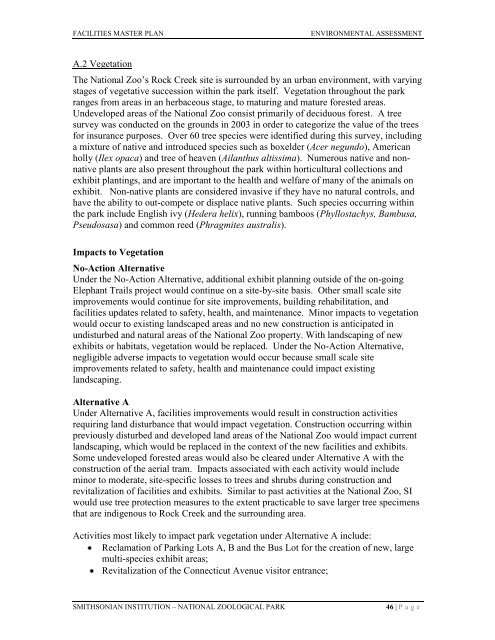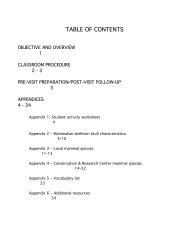facilities renewal master plan - National Zoo - Smithsonian Institution
facilities renewal master plan - National Zoo - Smithsonian Institution
facilities renewal master plan - National Zoo - Smithsonian Institution
Create successful ePaper yourself
Turn your PDF publications into a flip-book with our unique Google optimized e-Paper software.
FACILITIES MASTER PLAN ENVIRONMENTAL ASSESSMENT<br />
A.2 Vegetation<br />
The <strong>National</strong> <strong>Zoo</strong>’s Rock Creek site is surrounded by an urban environment, with varying<br />
stages of vegetative succession within the park itself. Vegetation throughout the park<br />
ranges from areas in an herbaceous stage, to maturing and mature forested areas.<br />
Undeveloped areas of the <strong>National</strong> <strong>Zoo</strong> consist primarily of deciduous forest. A tree<br />
survey was conducted on the grounds in 2003 in order to categorize the value of the trees<br />
for insurance purposes. Over 60 tree species were identified during this survey, including<br />
a mixture of native and introduced species such as boxelder (Acer negundo), American<br />
holly (Ilex opaca) and tree of heaven (Ailanthus altissima). Numerous native and nonnative<br />
<strong>plan</strong>ts are also present throughout the park within horticultural collections and<br />
exhibit <strong>plan</strong>tings, and are important to the health and welfare of many of the animals on<br />
exhibit. Non-native <strong>plan</strong>ts are considered invasive if they have no natural controls, and<br />
have the ability to out-compete or displace native <strong>plan</strong>ts. Such species occurring within<br />
the park include English ivy (Hedera helix), running bamboos (Phyllostachys, Bambusa,<br />
Pseudosasa) and common reed (Phragmites australis).<br />
Impacts to Vegetation<br />
No-Action Alternative<br />
Under the No-Action Alternative, additional exhibit <strong>plan</strong>ning outside of the on-going<br />
Elephant Trails project would continue on a site-by-site basis. Other small scale site<br />
improvements would continue for site improvements, building rehabilitation, and<br />
<strong>facilities</strong> updates related to safety, health, and maintenance. Minor impacts to vegetation<br />
would occur to existing landscaped areas and no new construction is anticipated in<br />
undisturbed and natural areas of the <strong>National</strong> <strong>Zoo</strong> property. With landscaping of new<br />
exhibits or habitats, vegetation would be replaced. Under the No-Action Alternative,<br />
negligible adverse impacts to vegetation would occur because small scale site<br />
improvements related to safety, health and maintenance could impact existing<br />
landscaping.<br />
Alternative A<br />
Under Alternative A, <strong>facilities</strong> improvements would result in construction activities<br />
requiring land disturbance that would impact vegetation. Construction occurring within<br />
previously disturbed and developed land areas of the <strong>National</strong> <strong>Zoo</strong> would impact current<br />
landscaping, which would be replaced in the context of the new <strong>facilities</strong> and exhibits.<br />
Some undeveloped forested areas would also be cleared under Alternative A with the<br />
construction of the aerial tram. Impacts associated with each activity would include<br />
minor to moderate, site-specific losses to trees and shrubs during construction and<br />
revitalization of <strong>facilities</strong> and exhibits. Similar to past activities at the <strong>National</strong> <strong>Zoo</strong>, SI<br />
would use tree protection measures to the extent practicable to save larger tree specimens<br />
that are indigenous to Rock Creek and the surrounding area.<br />
Activities most likely to impact park vegetation under Alternative A include:<br />
Reclamation of Parking Lots A, B and the Bus Lot for the creation of new, large<br />
multi-species exhibit areas;<br />
Revitalization of the Connecticut Avenue visitor entrance;<br />
SMITHSONIAN INSTITUTION – NATIONAL ZOOLOGICAL PARK 46 | P a g e

















